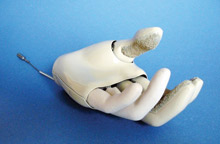Researchers from the Netherlands have concluded that despite advancements in myoelectric prosthetic hands, they have found no new improvements in the development of body-powered prosthetic hands in more than 20 years. The study was published in the current issue of the Journal of Rehabilitation Research & Development (JRRD) (Vol. 4, 2012).

Researchers said that the Sierra prosthetic hand from 1945 performed better than the newer hands they tested. The inner hand, sans cosmetic glove, is shown in the photo. Photograph courtesy of TU Delft.
The primary goal of the study was to evaluate the mechanical performance of adult-size voluntary opening (VO) prosthetic terminal devices and select the best tested device. A second goal was to see whether VO devices have improved in the last two decades. Nine devices-four hooks and five hands-were quantitatively tested (Hosmer model 5XA hook, Hosmer Sierra 2 Load VO hook, RSL Steeper Carbon Gripper, Ottobock model 10A60 hook, Becker Imperial hand, Hosmer Sierra VO hand, Hosmer Soft VO hand, RSL Steeper VO hand, and Ottobock VO hand).
The researchers, from the Delft University of Technology (TU Delft), Netherlands, and the University of Groningen, Netherlands, measured the pinch forces, activation forces, cable displacements, mass, and opening span and calculated the work and lag time. They also compared these results to measurements from 1987 (Mechanical comparison of terminal devices, Clinical Prosthetics & Orthotics, 11(4):235-244). According to their test results, the hooks required lower activation forces and delivered higher pinch forces than hands. The Hosmer model 5XA hook with three bands was the best tested hook, and the Hosmer Sierra VO hand was the best tested hand. The researchers also found that their data comparison indicated that VO prosthetic devices have not improved since 1987.
“The study offers a possible explanation why over half of all people with a body-powered prosthetic hand do not use it or even wear it,” said TU Delft researcher Gerwin Smit, PhD. “Besides this, some prosthetic arm users tend to suffer overload problems over time. These problems may well be a result of the excessive operating force required.” This is currently being researched further at both universities.
The question that the researchers raised as a result of this study was why there hasn’t been more investment in body-powered prostheses. “With current technology it must be possible to easily improve prostheses, resulting in enormous progress for those who have to use them,” Smith said. To address this, TU Delft aims to develop a lightweight prosthetic hand with a lower operating force and a higher grip strength.




